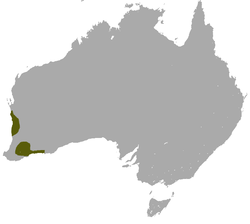| White-tailed dunnart | |
|---|---|
| Scientific classification | |
| Kingdom: | Animalia |
| Phylum: | Chordata |
| Class: | Mammalia |
| Infraclass: | Marsupialia |
| Order: | Dasyuromorphia |
| Family: | Dasyuridae |
| Genus: | Sminthopsis |
| Species: | S. granulipes |
| Binomial name | |
| Sminthopsis granulipes | |
 | |
| White-tailed dunnart range | |
The white-tailed dunnart (Sminthopsis granulipes), also known as the ash-grey dunnart, is a dunnart native to Australia. [3]
